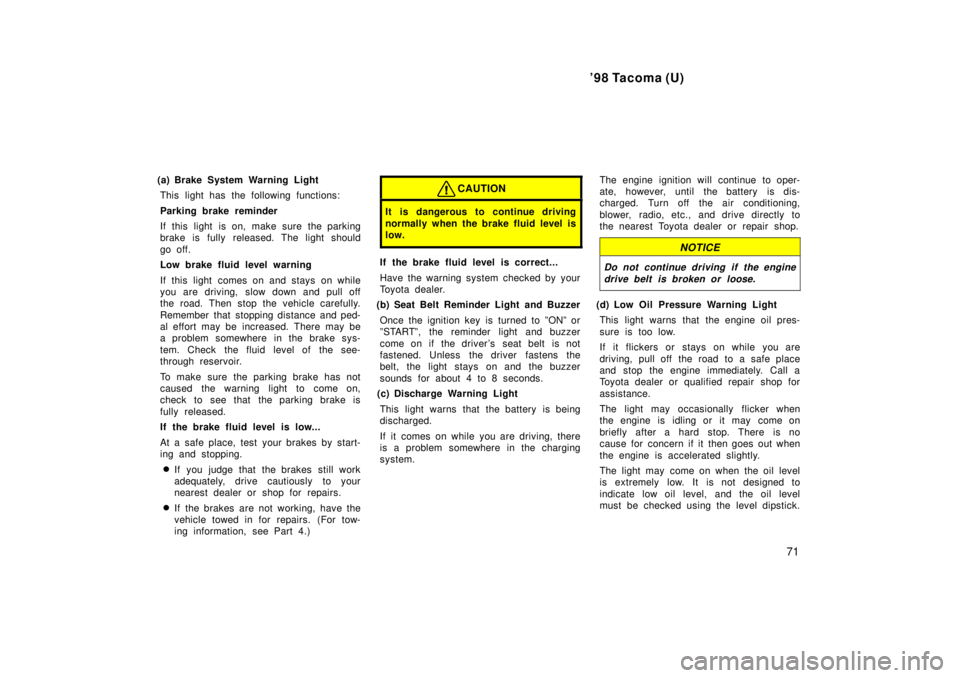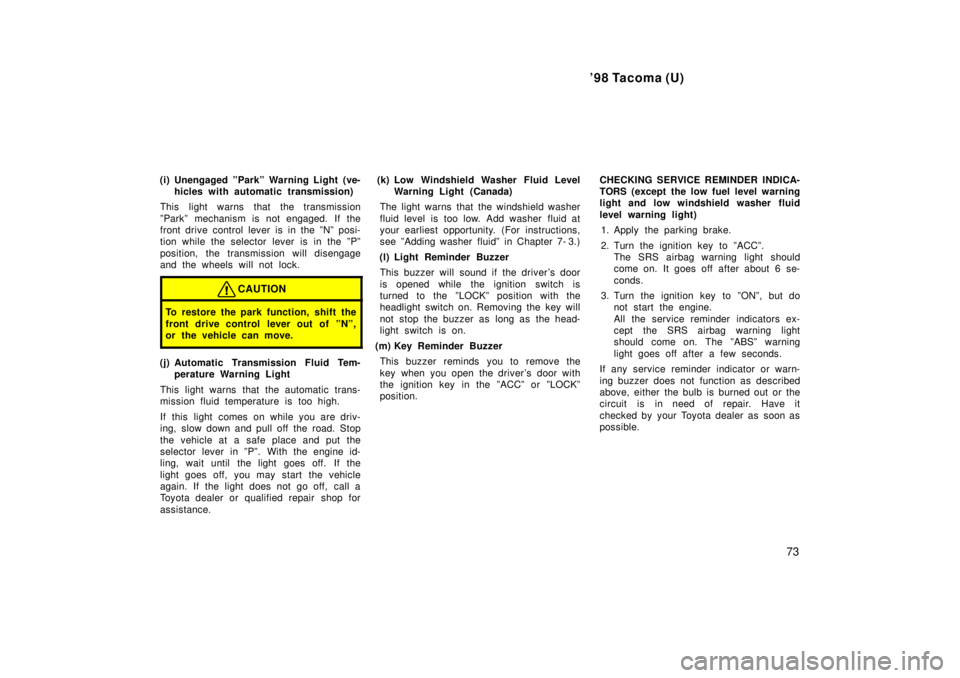1998 TOYOTA TACOMA warning light
[x] Cancel search: warning lightPage 6 of 246

'98 Tacoma (U)
6
Indicator symbols on the instrument panel
Automatic transmission fluid temperature warning
light
*
1
SRS airbag warning light *
1
Unengaged ºParkº warning light *
1
Anti-lock brake system warning light *
1
Seat belt reminder light
*
1
(type A)
(type B)
Low oil pressure warning light *
1
Low fuel level warning light *
1
Brake system warning light
*
1
Discharge warning light *
1
Malfunction indicator lamp *
1
Low windshield washer fluid level warning light *
1
Headlight high beam indicator light
Overdrive-off indicator light
Turn signal indicator lights
Driving
pattern
(POWER
mode)
indicator
light
Automatic
transmission
indicator
lights
Four-wheel drive indicator light
Page 7 of 246

'98 Tacoma (U)7
*1
: For details, see ºService reminder indicators and warning buzz -
ersº in Chapter 1- 5.
* 2
: If this light flashes, see ºCruise controlº in Chapter 1- 6.
Cruise control indicator light *
2
Rear differential lock indicator light
Page 32 of 246

'98 Tacoma (U)
32
This indicator comes on when the igni-
tion key is turned to the ºACCº or
ºONº position. It goes off after about
6 seconds. This means the SRS airbags
are operating properly.
The SRS airbag warning light system
monitors the airbag sensor assembly, in-
flators, warning light, interconnecting wir-
ing and power sources. (For details, see
Service remainder indicators and warning
buzzersº in chapter 1- 5.)The SRS airbag system is designed to
activate in response to a severe frontal
impact within the shaded area between
the arrows in the illustration.
There may be the case that the SRS air-
bags will not activate with such an impact
in which the occupant wearing the seat
belt correctly would not get serious injury.
The SRS airbags will deploy if the severi-
ty of the impact is above the designed
threshold level, comparable to an approxi-
mate 20 km/h (14 mph) collision when
impacting straight into a fixed barrier that
does not move or deform.
If the severity of the impact is below the
above threshold level, the SRS airbags
may not deploy. However, this threshold velocity will be
considerably higher if the vehicle strikes
an object, such as a parked vehicle or
sign pole, which can move or deform on
impact, or if it is involved in an underride
collision (e.g. a collision in which the nose
of the vehicle ºunderridesº, or goes under,
the bed of a truck).
It is possible with collision severity at the
marginal level of airbag sensor detection
and activation that only one of your ve-
hicle's two airbags will deploy.
For the safety of all occupants, be sure
to always wear seat belts.
Page 33 of 246

'98 Tacoma (U)33
Collision from the rear
Collision from the side Vehicle roll- over
The SRS airbags are not designed to
inflate if the vehicle is subjected to a
side or rear impact, if it rolls over, or
if it is involved in a low- speed frontal
collision.
The SRS airbag system mainly consists of
the following components and their loca-
tions are shown in the illustration.
1 SRS airbag warning light
2 Airbag module for driver (airbag and inflator)
3 Passenger airbag cutoff switch
4 Airbag module for passenger (airbag and inflator)
5 Airbag sensor assembly
The airbag sensor assembly consists of a
safing sensor and airbag sensor. In a severe frontal impact, sensors detect
deceleration and the system triggers the
airbag inflators. Then a chemical reaction
in the inflators momentarily fills the air-
bags with non- toxic gas to help restrain
the forward motion of the occupants.
When the airbags inflate, they produce a
fairly loud noise and release some smoke
along with non- toxic gas. This does not
indicate a fire. Be sure to wash off any
residue as soon as possible to prevent
minor skin irritation.
Deployment of the airbags happen in a
fraction of a second, so the airbags must
inflate with considerable force. While the
system is desi
gned to reduce serious inju-
ries, it may also cause minor burns or
abrasions and swellings.
Parts of the airbag module (steering wheel
hub, dashboard) may be hot for several
minutes, but the airbags themselves will
not be hot. The airbags are designed to
inflate only once.
A crash severe enough to inflate the air-
bags may break the windshield as the
vehicle buckles. In vehicles with a pas-
senger airbag the windshield may also be
damaged by absorbing some of the force
of the inflating airbag.
Page 67 of 246

'98 Tacoma (U)67
Part 1
OPERATION OF
INSTRUMENTS AND
CONTROLSÐ
Chapter 1- 5
Gauges, Meters
and Service reminder indicators �
Fuel gauge
�Engine coolant temperature gauge
�Tachometer
�Odometer and two trip meters
�Service reminder indicators and
warning buzzers
Fuel gauge
With tachometer
Without tachometer
The gauge works when the ignition
switch is on and indicates the approxi-
mate quantity of fuel remaining in the
tank.
Nearly fullÐNeedle at ºFº
Nearly emptyÐNeedle at ºEº
It is a good idea to keep the tank over
1/4 full.
This fuel gauge has a non-return type
needle which remains at the last indicated
position when the ignition switch is turned
off.
If the fuel level approaches ºEº or the low
fuel level warning light comes on, fill the
fuel tank as soon as possible.
On inclines or curves, due to the move-
ment of fuel in the tank, the fuel gauge
needle may fluctuate or the low fuel level
warning light may come on earlier than
usual.
If the fuel tank is completely empty, the
malfunction indicator lamp comes on. Fill
the fuel tank immediately.
The indicator lamp goes off after driving
several times. If the indicator lamp does
not go off, contact your Toyota dealer as
soon as possible.
Page 71 of 246

'98 Tacoma (U)71
(a) Brake System Warning Light
This light has the following functions:
Parking brake reminder
If this light is on, make sure the parking
brake is fully released. The light should
go off.
Low brake fluid level warning
If this light comes on and stays on while
you are driving, slow down and pull off
the road. Then stop the vehicle carefully.
Remember that stopping distance and ped-
al effort may be increased. There may be
a problem somewhere in the brake sys-
tem. Check the fluid level of the see-
through reservoir.
To make sure the parking brake has not
caused the warning light to come on,
check to see that the parking brake is
fully released.
If the brake fluid level is low...
At a safe place, test your brakes by start-
ing and stopping.
� If you judge that the brakes still work
adequately, drive cautiously to your
nearest dealer or shop for repairs.
� If the brakes are not working, have the
vehicle towed in for repairs. (For tow-
ing information, see Part 4.)
CAUTION
It is dangerous to continue driving
normally when the brake fluid level is
low.
If the brake fluid level is correct...
Have the warning system checked by your
Toyota dealer.
(b) Seat Belt Reminder Light and Buzzer
Once the ignition key is turned to ºONº or
ºSTARTº, the reminder light and buzzer
come on if the driver's seat belt is not
fastened. Unless the driver fastens the
belt, the light stays on and the buzzer
sounds for about 4 to 8 seconds.
(c) Discharge Warning Light
This light warns that the battery is being
discharged.
If it comes on while you are driving, there
is a problem somewhere in the charging
system. The engine ignition will continue to oper-
ate, however, until the battery is dis-
charged. Turn off the air conditioning,
blower, radio, etc., and drive directly to
the nearest Toyota dealer or repair shop.
NOTICE
Do not continue driving if the engine
drive belt is broken or loose.
(d) Low Oil Pressure Warning Light
This light warns that the engine oil pres-
sure is too low.
If it flickers or stays on while you are
driving, pull off the road to a safe place
and stop the engine immediately. Call a
Toyota dealer or qualified repair shop for
assistance.
The light may occasionally flicker when
the engine is idling or it may come on
briefly after a hard stop. There is no
cause for concern if it then goes out when
the engine is accelerated slightly.
The light may come on when the oil level
is extremely low. It is not designed to
indicate low oil level, and the oil level
must be checked using the level dipstick.
Page 72 of 246

'98 Tacoma (U)
72
NOTICE
Do not drive the vehicle with the warning light onÐeven for one block.It may ruin the engine.
(e) Malfunction indicator lamp
This lamp comes on in the following
cases.
a. The fuel tank is completely empty. (See
ºFuel gaugeº in Chapter 1- 5 for instruc-
tions.)
b. The fuel tank cap is not tightened se-
curely. (See ºFuel tank capº in Chapter
1- 2 for instructions.)
c. There is a problem somewhere in your
engine or automatic transmission electrical
system.
If it comes on while you are driving in
case c, have your vehicle checked/re-
paired by your Toyota dealer as soon as
possible. (f) Low Fuel Level Warning Light
This light comes on when the fuel level
in the tank becomes nearly empty. Fill up
the tank as soon as possible.
On inclines or curves, due to the move-
ment of fuel in the tank, the low fuel level
warning light may come on earlier than
usual.
(g) ºABSº Warning Light This light warns that there is a problem
somewhere in your anti-lock brake system.
If the light comes on while you are driv-
ing, have your vehicle checked by your
Toyota dealer as soon as possible.
The light will come on when the ignition
key is turned to the ºONº position. After
a few seconds, the light will go off.
When the ºABSº warning light is on (and
the brake system warning light is off), the
brake system operates conventionally but
anti- lock brake system is not assisting
brake performance so that the wheels can
lock- up during sudden braking or braking
on slippery road surfaces. Vehicles with rear differential lock sys-
temÐ
The anti-lock brake system does not oper-
ate when the rear differential is locked. It
is normal operation for the ºABSº warning
light to be on at this time.
(h) SRS Airbag Warning Light This light will come on when the igni-
tion key is turned to the ºACCº or
ºONº position. After about 6 seconds,
the light will go off. This means the
airbag system is operating properly.
The warning light system monitors the air-
bag sensor assembly, inflator, warning
light, interconnecting wiring and power
sources.
If either of the following conditions occurs,
this indicates a malfunction somewhere in
the parts monitored by the warning light
system. Contact your Toyota dealer as
soon as possible to service the vehicle.
� The light does not come on when the
ignition key is turned to the ºACCº or
ºONº position or remains on.
� The light comes on while driving.
Page 73 of 246

'98 Tacoma (U)73
(i) Unengaged ºParkº Warning Light (ve-
hicles with automatic transmission)
This light warns that the transmission
ºParkº mechanism is not engaged. If the
front drive control lever is in the ºNº posi-
tion while the selector lever is in the ºPº
position, the transmission will disengage
and the wheels will not lock.
CAUTION
To restore the park function, shift the
front drive control lever out of ºNº,
or the vehicle can move.
(j) Automatic Transmission Fluid Tem- perature Warning Light
This light warns that the automatic trans-
mission fluid temperature is too high.
If this light comes on while you are driv-
ing, slow down and pull off the road. Stop
the vehicle at a safe place and put the
selector lever in ºPº. With the engine id-
ling, wait until the light goes off. If the
light goes off, you may start the vehicle
again. If the light does not go off, call a
Toyota dealer or qualified repair shop for
assistance. (k) Low Windshield Washer Fluid Level
Warning Light (Canada)
The light warns that the windshield washer
fluid level is too low. Add washer fluid at
your earliest opportunity. (For instructions,
see ºAdding washer fluidº in Chapter 7- 3.)
(l) Light Reminder Buzzer This buzzer will sound if the driver 's door
is opened while the ignition switch is
turned to the ºLOCKº position with the
headlight switch on. Removing the key will
not stop the buzzer as long as the head-
light switch is on.
(m) Key Reminder Buzzer This buzzer reminds you to remove the
key when you open the driver 's door with
the ignition key in the ºACCº or ºLOCKº
position. CHECKING SERVICE REMINDER INDICA-
TORS (except the low fuel level warning
light and low windshield washer fluid
level warning light)
1. Apply the parking brake.
2. Turn the ignition key to ºACCº. The SRS airbag warning light should
come on. It goes off after about 6 se-
conds.
3. Turn the ignition key to ºONº, but do not start the engine.
All the service reminder indicators ex-
cept the SRS airbag warning light
should come on. The ºABSº warning
light goes off after a few seconds.
If any service reminder indicator or warn-
ing buzzer does not function as described
above, either the bulb is burned out or the
circuit is in need of repair. Have it
checked by your Toyota dealer as soon as
possible.